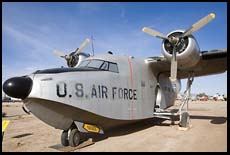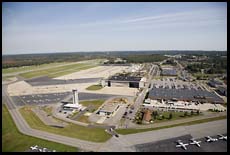Multi-engine Training

Multi-engine Training |

|
 We offer a three-day multi-engine training course for pilots
holding a Commercial airplane single-engine land certificate.
We offer a three-day multi-engine training course for pilots
holding a Commercial airplane single-engine land certificate.
Other instructors at East Coast Aero Club have more than 5,000 hours of teaching experience.
 We will do our training at Hanscom Field (KBED), one of the
Northeast U.S.'s busiest airports with a mix of single-engine airplane
trainers, personal turboprops, business jets, U.S. Air Force planes,
and helicopter training. Hanscom is an active U.S. Air Force base, with
thousands of researchers and administrators working on the military side
of the field, but no based aircraft. The airport has a 7000' main
runway and a 5000' crosswind runway.
We will do our training at Hanscom Field (KBED), one of the
Northeast U.S.'s busiest airports with a mix of single-engine airplane
trainers, personal turboprops, business jets, U.S. Air Force planes,
and helicopter training. Hanscom is an active U.S. Air Force base, with
thousands of researchers and administrators working on the military side
of the field, but no based aircraft. The airport has a 7000' main
runway and a 5000' crosswind runway.
If your radio skills are rusty, Hanscom is a great place to practice them. We have separate frequencies for ATIS, clearance, ground, and tower. Each of the two FBOs has its own frequency as well.
Once in the practice area, we do some 30-degree bank clearing turns, then 45-degree steep turns, then 50-degree steep turns. We slow down to 60-65 knots with the gear and three notches of flaps extended and do some standard-rate turns.
We then pull the power back to 16" of manifold pressure and try to hold altitude, resulting in a power-off stall in the landing configuration (gear, flaps, power). Remember not to let a stall develop. Multi-engine planes are not required to be spin-recoverable. You can and should recover at the first indication of a stall, which might be the stall warning horn sounding. Recover from the stall as you would in a single-engine airplane, adding full power (all six levers go forward), retracting the third notch of flaps (down to two now; careful not to let the lever fall to the floor and give up all of your flaps).
Once the airplane is cleaned up, we might as well do a departure stall. Accelerate to the normal rotation speed of 75 knots. A full power departure stall on a twin-engine airplane will require an extremely nose-high attitude, perhaps normal for an aerobatic pilot, but likely to frighten the average person. The PTS says that the power-on stall should be done at 65 percent power or greater, which is about 22" of manifold pressure. Bring the plane up to a 17-degree nose-up attitude.
On the way back to the airport, be sure to look in all directions for traffic. Hanscom is a very busy airport and the examiner will want to see that you are vigilant about scanning for other aircraft.
Fly the pattern with about 20" of manifold pressure, 2400 RPM, on downwind, aiming for 100 knots. Gear down mid-field. Abeam the numbers, pull the power back to 16 or 17" and add a notch of flaps. Trim for 90 knots on base and add a second notch of flaps. Trim for 80 knots on final with three notches of flaps in.
We will do an emergency descent. This is something you would be more likely to do in a pressurized aircraft, but it is a required maneuver for a multi-engine rating in any airplane. From a normal cruising speed below 140 knots indicated, pull the power back to idle, push the props forward for maximum drag, drop the landing gear, and pitch the nose down to maintain 140 knots, which is the maximum landing gear extended speed.
Return to Hanscom for pattern work, including short-field approach with full flaps at 75 knots.
Work on learning to recognize which engine is failing by the nose yaw. The instructor will cover the throttle quadrant with a chart and gradually pull back one throttle. Without looking at the engine instruments, figure out which engine is failing.
The instructor pulls the throttle all the way back to idle on one engine. Practice identify-verify-feather, gradually pulling the prop lever back on the "dead" engine, but the instructor will prevent you from actually feathering the engine. You've demonstrated that you could have done it, so the instructor will push the prop control back up to a synced position with the running engine and set the throttle for "zero thrust", about 12" in the Seminole. This is equivalent aerodynamically to the engine being shut down and feathered.
Do some climbs, turns, and descents with only one engine running. Apply rudder trim (very stiff and difficult to move in our Seminoles). Put the hood on and fly around for another few minutes in the practice area, then return to Hanscom. Take the hood off, enter the downwind, and put the gear down as the same place that you would with both engines running. You have enough power to hold straight and level with the gear down and it is better to keep procedures consistent. Between 23 and 25" should hold you on the downwind, then 20" for base and final.
Try a single-engine landing to a full stop. The trick here is that the simulated dead engine's throttle isn't touched. It stays at zero thrust. When you pull back the throttle on the good engine, therefore, you'll end up with a yaw in the opposite direction now that the good engine's idle prop is generating more drag than the "dead" engine. Maintain directional control with the rudder and hold the centerline with the ailerons, as in any other landing. Be gradual about everything. In a real-life engine failure, you are going to land on a long runway. There is no prize for landing short with one engine inoperative. Use all 7000' at Hanscom if you want to.
Fly out to the practice area under the hood. Climb to 3000' and set up the airplane for a departure: no flaps, full power, climb attitude. The instructor will pull back the throttle on one engine. Identify, verify, and simulate feathering. The instructor will then set zero thrust on the "dead engine" while you establish a Vyse climb on the good engine. Note the anemic climb rate.
This is a good time for a drag demonstration. We have one engine at full power and one at zero thrust. Pull back the good engine just enough to stop the climb, staying at Vyse. You won't touch the power again. Drop the landing gear and, once you've restabilized at Vyse (blue line; 88 knots), note the descent rate on the VSI. Pull the gear back up. Extend full flaps and note the descent rate at Vyse. Extend the landing gear again and note the "gear and flaps" descent rate. Clean up the airplane once again and make sure that you're trimmed for Vyse. Now set up the failed engine in its maximum drag configuration: throttle back; prop forward. Note the descent rate from the dragging prop.
What are you supposed to learn from this? That the landing gear won't pull you down out of the sky. That, if you've only got one engine, full flaps should not be extended until you're almost on top of the runway. That the drag from a windmilling prop is substantial and feathering is very important.
Put the hood back on and head towards Keene (KEEN). At some point, the instructor will turn off the fuel selector for one engine, which will sputter and quit. You're in cruise, not on climbout, so after you've stopped any yaw, spend a few moments seeing if you can get the engine to restart. Perhaps it is as simple as the mixture control, carb ice, the magneto switches, alternate air, the fuel selector valve, etc. Pretend that you can't get the engine to run again. As soon as you've given up, pull the prop control to feather. (If the airplane starts to yaw, you're pulling on the wrong prop control!) Then get out the checklist to secure the engine.
Fly around a bit with one engine secured, keeping the hood on, then run the in-flight restart checklist as you're back inbound to Hanscom. After the engine has "started" (prop windmilling), check the gauges to make sure that the RPM is sensible. A prop speed below 2500 RPM probably means that the mixture hasn't been advanced and the engine is only appearing to run. Once you're sure that both engines are running smoothly, gauages in the green, cowl flaps where they should be, do a short-field approach and landing (75 knots), then a no-flap landing (85 knots).
Wearing the hood, climb out to the practice area. Configure the airplane for climb-out: gear up, flaps up, 88 knots. Bring back the throttle on the "critical engine" (supposedly arbitrarily defined to be the left engine on the Seminole) to idle, i.e., prop windmilling. Keep pitching and trimming up to reduce airspeed while simultaneously adding rudder to maintain heading. When the rudder is all the way to the floor or the stall warning horn chirps, you've reached Vmc. Recovery involves reducing power on the good engine and lowering the nose to pick up airspeed. Remember that the Piper POH says not to stall the airplane with one engine inop.
With the hood on and one engine set to zero thrust, do an ILS approach to a published missed. Use the autopilot for the vectoring portion of the approach and the flight director when coming down the glide slope. Note the anemic climb performance on the missed. Do not attempt a missed approach or any other kind of go-around with one engine shut down.
Remove the hood and do an emergency descent, then an emergency gear extension. Put the hood back on and do a non-precision approach to a full stop.
Remove hood and practice an engine failure during climbout. Practice an engine failure during a steep turn. Practice an engine failure in landing configuration at 80 knots, with a goal of returning to a lower drag configuration (2 notches of flaps instead of 3), a higher airspeed of 90 knots, and the same descent rate (no need to feather as we would already be coming down final).
Put the hood back on and do an ILS approach using the flight director. At some point during the approach, the instructor will simulate an engine failure. Continue the approach on one engine and land with one engine at zero thrust.